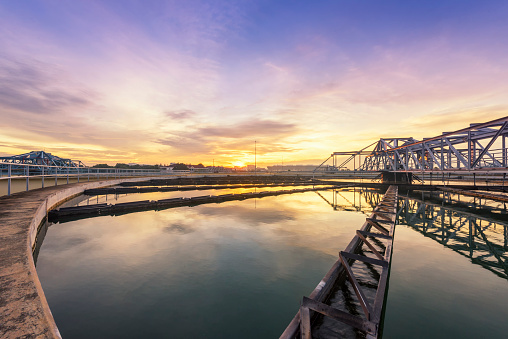Large-scale facilities use water treatment polymer for optimized water recycling.
Large-scale facilities use water treatment polymer for optimized water recycling.
Blog Article
Discover Just How Water Treatment Polymer Features in Efficient Wastewater Treatment Systems
The combination of water therapy polymers right into wastewater therapy systems stands for a significant development in enhancing operational effectiveness. These polymers work mostly via devices of coagulation and flocculation, properly accumulating put on hold fragments for simpler removal. Their adaptability throughout varying environmental conditions adds to improved sedimentation and decreased sludge quantity. However, understanding the particular sorts of polymers and their applications can reveal deeper understandings right into maximizing treatment procedures. What effects do these improvements hold for future wastewater administration methods?
Introduction of Water Treatment Polymers
The performance of wastewater administration hinges on the application of different treatment representatives, amongst which water treatment polymers play a crucial function. These artificial or all-natural polymers are designed to boost the effectiveness of physical and chemical processes in wastewater therapy systems. Their primary feature is to help with the gathering of suspended fragments, eventually boosting the general top quality of treated water.
Water therapy polymers can be categorized into a number of groups, including flocculants, coagulants, and dispersants. Coagulants reduce the effects of the charges of put on hold particles, enabling them to come with each other and settle much more properly.
The application of these polymers not only enhances the removal of impurities but also enhances the functional performance of therapy plants. Additionally, the selection of proper water therapy polymers is essential, as their efficiency can differ based upon variables such as water chemistry, temperature, and turbidity levels. In general, water treatment polymers are necessary parts in modern-day wastewater management strategies, contributing to cleaner water and sustainable environmental practices.
Mechanisms of Coagulation and Flocculation
Coagulation and flocculation are fundamental procedures in wastewater treatment that symbolize the principles of fragment interaction and aggregation. These devices are important for removing put on hold solids, colloids, and other contaminants from water.
Adhering to coagulation, flocculation occurs, identified by the gentle blending of water to motivate the development of bigger aggregates, or flocs. Throughout this phase, polymers play a substantial role by linking between fragments, enhancing the development of these bigger aggregates. The physical and chemical communications during flocculation outcome in a raised size and thickness of the particles, promoting their succeeding elimination with sedimentation or filtration.
The efficiency of coagulation and flocculation processes is influenced by numerous factors, including pH, temperature level, and the nature of the contaminants existing. Understanding these systems permits for the optimization of wastewater treatment systems, causing boosted removal effectiveness and total water quality. The cautious choice and application of coagulants and flocculants are vital for successful wastewater administration.
Types of Water Treatment Polymers
Often used in wastewater therapy, water therapy polymers are important for enhancing the efficiency of coagulation and flocculation processes. These polymers can be broadly categorized into 3 major kinds: anionic, cationic, and non-ionic.
Anionic polymers, which carry a negative cost, are specifically efficient in dealing with wastewater with favorably billed pollutants. Conversely, cationic polymers have a favorable fee and are typically used in applications where negatively billed fragments control, such as in specific industrial effluents.
Non-ionic polymers, doing not have a fee, function as functional representatives that can browse this site improve the performance of both anionic and cationic polymers. Their key function includes increasing the thickness of the wastewater, consequently improving the total retention time of the flocs in the therapy system.
Comprehending the distinctive features of these kinds of water treatment polymers enables the optimization of wastewater treatment procedures, eventually resulting in boosted removal efficiencies and better water high quality.
Applications in Wastewater Treatment
In metropolitan wastewater treatment plants, water treatment polymers help in reducing the quantity of sludge generated during the treatment process. water treatment polymer. This decrease not just maximizes functional efficiency but likewise lessens disposal prices connected with sludge management. Additionally, polymers are important in dealing with commercial effluents, where they help in the elimination of details impurities such as hefty steels and organic toxins, guaranteeing conformity with ecological laws

Furthermore, water therapy polymers are made use of in the improvement of biofiltration systems, where they boost microbial task and general treatment efficiency. Their role in membrane layer procedures, such as reverse osmosis, likewise can not be neglected, as they contribute to membrane fouling water treatment polymer control and prolong the life-span of purification systems. With these diverse applications, water treatment polymers are essential for attaining reliable and lasting wastewater monitoring.

Advantages of Utilizing Polymers
The use of water therapy polymers in wastewater systems provides numerous advantages that considerably enhance therapy effectiveness and total functional efficiency. These polymers act as efficient coagulants and flocculants, promoting the aggregation of put on hold solids and facilitating their elimination. This process causes clearer effluent and minimizes the burden on downstream therapy stages.
Furthermore, polymers boost the dewatering process by boosting the sedimentation characteristics of sludge. This leads to reduced volume and weight of waste product, ultimately reducing disposal prices. Their ability to operate across varying pH degrees and temperature levels guarantees versatility in various wastewater environments.
Polymers likewise add to the stablizing of organic procedures by providing nutrients and preserving ideal problems for microbial development - water treatment polymer. This bolstered microbial activity aids in the break down of natural issue, improving total therapy performance
Furthermore, using polymers can result in minimized chemical use, lessening functional prices and ecological impact. By maximizing the therapy procedure and boosting sludge monitoring, water therapy polymers play a crucial role in promoting lasting wastewater monitoring practices, lining up with regulative requirements and ecological goals.
Final Thought
In conclusion, water therapy polymers are crucial for improving the effectiveness of wastewater treatment systems. Their capacity to promote coagulation and flocculation procedures leads to enhanced sedimentation and minimized sludge quantity, therefore maximizing therapy performance.
Report this page